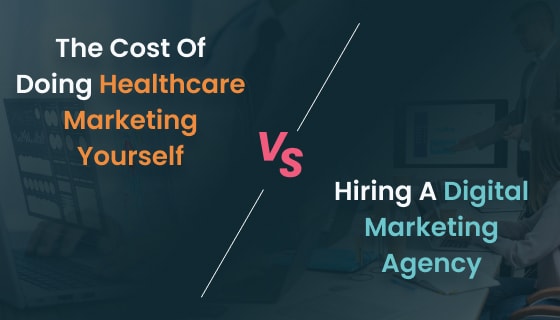Introduction
In the evolving world of healthcare, the impact of Healthcare Content Marketing cannot be overstated. This innovative approach goes beyond conventional advertising, emphasizing creating and distributing meaningful, pertinent, and regular content. This strategy is vital in attracting and maintaining a specific audience — primarily potential and existing patients.
Healthcare Content Marketing stands at the crossroads of information, education, and trust-building. It’s a strategic tool that informs, educates, and connects with patients on a deeper level, fostering trust. This trust is pivotal in transforming healthcare providers’ perceptions, transitioning them from mere service providers to trusted health advisors.
In this guide, we will explore the healthcare content marketing role, tips to develop content strategy, how to engage your target audience, and more to help you confidently navigate this competitive landscape.
The Role Of Healthcare Content Marketing
Healthcare Content Marketing is a transformative force in the healthcare industry, transcending conventional marketing practices. It takes on an educational approach, providing valuable information that empowers patients to make informed decisions about their health.
Fostering trust through transparency and patient-centric content establishes a strong foundation for long-lasting patient relationships. Furthermore, it engages patients through various interactive platforms, nurturing a sense of community and facilitating meaningful interactions. Here’s a deeper look at its role:
Educational Approach
Healthcare Content Marketing’s educational approach is centered on producing informative content that enlightens the audience about various health conditions, cutting-edge treatments, and essential preventive healthcare tips.
This strategy is dedicated to simplifying complex medical information, thereby making healthcare more accessible and understandable to the general public.
Building Trust
Building trust is paramount in the healthcare sector, which can be achieved through various strategies. Healthcare providers can establish themselves as a reliable source of information by consistently offering accurate and up-to-date health information.
This informs patients and positions the providers as authoritative figures in the field. It helps build long-term relations and trust among prospective patients.
Patient Engagement
Patient engagement is a critical aspect of modern healthcare, and it can be significantly enhanced through various interactive and personalized strategies.
First and foremost, utilizing interactive content such as Q&A sessions, webinars, and forums effectively engages patients. This approach makes them feel more involved and informed about their healthcare journey, fostering a deeper connection with their providers.
Developing A Robust Content Strategy In Healthcare
Developing a robust content strategy in healthcare is crucial for connecting and engaging with diverse audience groups. To achieve this, conduct thorough audience research to understand their specific needs, preferences, and concerns.
Next, establish clear goals and objectives for your content, aligning them with your healthcare organization’s mission and values. Create a content calendar to plan and organize your content production, ensuring a consistent and timely information delivery.
Prioritize patient education and empowerment by providing accurate, reliable, and easily digestible healthcare information. Let us walk you through the vital tips for developing a healthcare content strategy.
Audience Analysis
In the field of healthcare, conducting thorough audience analysis is paramount for developing an effective content strategy. This process starts with identifying the various segments within the audience, including patients, healthcare providers, and caregivers, and understanding their distinct needs.
Utilizing tools such as surveys, focus groups, and online analytics is integral to understanding what each segment considers valuable and relevant.
Content Tailoring
Tailoring content in healthcare is key to engaging a diverse audience effectively. This involves using a variety of content formats such as articles, videos, infographics, and podcasts, catering to the different preferences of the audience.
Ensuring the content’s medical accuracy and relevance to current healthcare topics and trends is critical to maintaining credibility and educating the audience.
Consistent Messaging
Consistent messaging is imperative in healthcare communication to build trust and credibility. Establishing a clear and consistent brand voice that aligns with the healthcare organization’s values and mission is pivotal.
This voice should be evident across all content, ensuring the message resonates with the audience and reinforces the brand’s identity.
Engaging Healthcare Audiences With Quality Content
Engaging healthcare audiences effectively demands a thoughtful and strategic approach to content creation.
Start by embracing the power of storytelling in your healthcare content. Share patient success stories, highlight healthcare professionals’ expertise, and illustrate the impact of your services on the community.
Additionally, offer informative material that educates your audience about health conditions, treatments, and wellness practices. Make use of infographics, videos, and articles that simplify complex information.
Here’s how to do it:
Storytelling
Storytelling in healthcare plays a predominant role in connecting with the audience on a more personal and emotional level. By sharing real-life patient narratives that highlight their journeys and outcomes, healthcare providers can add a human element to their communications.
These stories showcase patient experiences and demonstrate the real-world impact of medical care and treatments.
Informative Material
Informative material is vital to healthcare communication, educating, and empowering the audience.
Keeping the audience informed about the latest medical developments, including research findings and treatment advancements, helps them stay up-to-date with the evolving healthcare landscape. Producing educational content such as articles, videos, and infographics is also crucial.
Interactive Content
In the healthcare sector, interactive content is a cornerstone for engaging and educating diverse audiences. Utilizing a variety of multimedia formats, including interactive infographics, educational videos, and podcasts, healthcare providers can cater to different learning styles, making their content both engaging and accessible.
These formats provide an immersive experience that transforms complex medical information into understandable and relatable content.
Effective Healthcare Communication In The Digital Age
Achieving effective healthcare communication in the digital age demands a multifaceted approach. Firstly, leverage various digital platforms to reach your target audience where they are most active, including social media, websites, email newsletters, and patient portals. Secondly, implement SEO strategies to optimize your content for search engines, making it easily discoverable and accessible to those seeking healthcare information.
Let us walk you through this imperative information in detail,
Digital Platforms Utilization
In the digital age, healthcare providers can effectively utilize platforms like Facebook, Twitter, and Instagram to engage with audiences by sharing health tips and news. Regularly updating blogs with informative articles and sharing them across these platforms further helps educate and inform the audience.
SEO Implementation
SEO implementation is paramount in enhancing the online presence and visibility of healthcare content. Keyword optimization plays a key role in this process.
Researching and incorporating relevant healthcare keywords can significantly amplify content visibility on search engines. Another important aspect is website optimization.
Ensuring the website is user-friendly, mobile-responsive, and faster loading times not only enhances the user experience but also positively impacts SEO rankings.
Diverse Content Creation
Diverse content creation is key to engaging a wide audience in the healthcare sector. By creating and hosting podcasts and webinars on various health topics, healthcare providers can offer valuable information and engage with their audience in a more interactive and personal format.
Infographics and other forms of visual content are also vital, as they can simplify complex medical information, making it more accessible and understandable to the general public. Additionally, video marketing is a powerful tool.
Digital Marketing Strategies For The Healthcare Sector
Digital marketing strategies for healthcare sector necessitate a comprehensive and patient-centric approach.
Firstly, engage with the community by actively participating in social media discussions, addressing concerns, and sharing informative content. Personalize your content to cater to individual patient needs, offering tailored recommendations and educational materials.
Additionally, optimize your digital presence for mobile users, ensuring that your website and content are accessible and user-friendly on various devices.
Here’s an expanded view of these strategies:
Social Media Engagement
Social media engagement is an integral part of healthcare communication strategies. Regular updates and information sharing, including health tips and industry news, are essential to keep the audience informed and engaged.
These frequent posts keep the audience in the loop and foster a sense of community. Creating interactive campaigns is another effective way to boost engagement and involvement.
Content Personalization
Content personalization in healthcare is essential for engaging different patient groups effectively. Targeted email marketing allows for sending customized emails that cater to the specific health interests or histories of patients, ensuring relevance and personal connection.
Additionally, creating user-specific web content that addresses the individual needs and questions of patients significantly enhances their online experience.
Incorporating feedback mechanisms into digital content is also crucial, as it provides valuable insights that help in further tailoring communication strategies.
Mobile Optimization
Responsive web design is predominant in modern healthcare communication, ensuring that websites automatically adjust and look great on any mobile device.
This adaptability enhances the user experience by providing a seamless interface regardless of the device used. Alongside this, creating mobile-friendly content is key.
Content must be easily readable and navigable on smartphones, which can be achieved through shorter paragraphs, larger fonts, and touch-friendly navigation options.
Strategies For Engaging Healthcare Audiences
Engaging healthcare audiences successfully involves a multifaceted approach. Begin by analyzing patient demographics to understand their specific needs and preferences.
Conduct regular surveys and polls to gather direct feedback on their healthcare concerns. Stay updated with evolving healthcare trends to address emerging issues and questions. Utilize digital platforms like social media, websites, and email newsletters to reach and interact with your audience effectively.
Understanding Audience Needs
To effectively meet the needs of your audience, we suggest employing several strategies. Firstly, thoroughly analyze patient demographics, enabling you to comprehend their unique healthcare concerns and interests.
Secondly, actively engage with your patients by conducting regular surveys and polls to gather their input, helping you determine the health information they value most.
Creating Relatable Content
We prioritize creating relatable content by adopting a multifaceted approach. Firstly, emphasize empathy in your communication, using language that reflects our understanding and compassion for patient experiences and challenges.
Secondly, provide educational and informative material that is clear, concise, and designed to empower patients with knowledge about health conditions and treatments.
Feedback Mechanism
To establish an effective feedback mechanism, we employ a variety of strategies. Firstly, we actively listen on digital platforms by consistently monitoring social media and other online channels to obtain insight into patient feedback and respond promptly to their concerns.
Leveraging Various Content Formats
Leveraging a variety of content formats in Healthcare Content Marketing is paramount for reaching and resonating with diverse audiences. Each format brings unique strengths to the table, catering to different learning styles and preferences.
For instance, Blogs and articles offer in-depth information, videos engage through visual storytelling, infographics simplify complex data, and podcasts provide auditory insights. Webinars facilitate real-time interactions, interactive tools engage users actively, and patient portals offer convenient access to healthcare services.
Here’s an expanded view of these content types:
Blogs And Articles
We suggest that your approach to creating blogs and articles should revolve around delivering valuable content to our audience.
Aim to produce educational posts that delve into various health issues, present new research findings, and provide wellness advice, catering to those who seek in-depth information.
Video Content
Your video content strategy should offer diverse and engaging content to your audience. We suggest creating informative videos that break down complex medical procedures into an easy-to-understand format, ensuring patients can access clear explanations.
Podcasts
Your podcast strategy should aim to provide informative and accessible content for your audience. We suggest producing a podcast series that delves into healthcare discussions, featuring conversations with medical experts on various health-related topics, ensuring your audience can access valuable insights.
Enhancing Online Visibility With SEO
Enhancing online visibility through SEO is an imperative component of Healthcare Content Marketing. A strategic SEO approach is crucial for ensuring that healthcare providers are readily discoverable by individuals seeking services and information online.
To effectively utilize SEO in this context, conduct thorough keyword research and identify relevant healthcare terms and phrases that potential patients will likely use in their searches.
Optimize your website content, including titles, meta descriptions, headers, and alt tags, with these keywords to bolster search engine rankings. Here’s how to effectively utilize SEO:
Keyword Research
Your keyword research strategy should be geared towards maximizing the effectiveness of your online presence. You can focus on identifying relevant terms by researching keywords associated with healthcare services, treatments, and conditions, aligning your content with what potential patients are actively searching for.
On-Page Optimization
Your on-page optimization strategy should aim to augment your website’s visibility and user experience. For that, you should meticulously optimize page elements such as titles, meta descriptions, and headers to incorporate targeted keywords, making your content more appealing to search engine users and increasing click-through rates from search engine results pages (SERPs).
Content Optimization
Your content optimization strategy should center on delivering valuable and user-friendly content to your audience. For that, prioritize quality content creation, ensuring your articles, blog posts, and other materials are informative and engaging, addressing patients’ needs and queries while seamlessly incorporating target keywords.
Building Trust With Patient Testimonials And Reviews
Building trust with patient testimonials and reviews is pivotal to Healthcare Content Marketing. These elements humanize healthcare services, providing prospective patients with relatable experiences and fostering trust.
Here are key strategies to effectively use testimonials and manage online reviews:
Showcasing Success Stories
Ensure your content optimization strategy is on the right track by prioritizing quality content creation that addresses the audience’s needs and incorporates relevant keywords for attracting and retaining visitors.
Regularly updating your content keeps your website fresh and signals to search engines that your site is actively maintained and relevant. This can positively impact your search engine ranking. Keep up the good work in providing valuable and user-friendly content to your audience.
Managing Online Reviews
Effective management of online reviews is crucial for your healthcare services. Prioritize actively monitoring platforms like Google, Yelp, and healthcare-specific review sites to stay updated on new feedback.
Engaging responsively is a core principle that involves promptly and professionally responding to positive and negative reviews.
Leveraging Reviews For Improvement
Understand the value of leveraging reviews to enhance your healthcare services continuously. Firstly, gather valuable insights by diligently analyzing patient reviews and identifying areas where you can improve patient care and the quality of your services.
Secondly, actively encourage satisfied patients to share their experiences by requesting reviews through follow-up emails or in-person visits, fostering a culture of feedback and improvement while helping potential patients make informed decisions about their healthcare choices.
Incorporating Reviews Into Marketing
Incorporating reviews into your marketing efforts is a powerful strategy. You can showcase your positive reviews in various marketing materials, including brochures, advertisements, and our website, using them as endorsements to build trust and credibility among potential patients.
Furthermore, you can leverage social proof by prominently highlighting patient satisfaction in your marketing campaigns, emphasizing your patients’ positive experiences to attract new individuals seeking high-quality healthcare services.
Multi-Channel Content Distribution
Multi-Channel Content Distribution is a vital strategy in Healthcare Content Marketing, ensuring valuable content reaches a diverse audience through various digital mediums. Here are some effective tactics to implement a successful multi-channel distribution approach:
Consistent Online Presence
Maintaining a consistent online presence is vital to your digital strategy. Prioritize regular content updates across all digital platforms by providing fresh and relevant material to keep your audience engaged and informed.
We suggest understanding the importance of tailoring content formats and messaging to align with each digital channel’s unique characteristics and user behavior, optimizing your reach and impact.
Cross-Channel Promotion
You should design your cross-channel promotion strategy with an aim to maximize the reach and impact of your content. Moreover, actively leverage social media platforms to promote various content types, such as blog posts, videos, and podcasts, encouraging users to visit your main website for more in-depth information.
Additionally, incorporate links to recent articles, blogs, or videos in your email newsletters, driving traffic and enhancing engagement.
Synergizing Content And Channels
Your approach to synergizing content and channels should center around creating a cohesive and effective digital presence. We suggest designing integrated campaigns where each channel works in harmony, leveraging the strengths of one to enhance the impact of another.
For example, you can use social media to extend the reach of your podcast series or blog content. Moreover, prioritize tracking cross-channel performance through analytics, allowing you to monitor user engagement and adjust strategies to ensure optimal performance.
Diverse Content Formats
Your strategy for diverse content formats should embrace flexibility and engagement. We suggest adapting content by repurposing it into various formats suitable for each platform, ensuring that you reach your audience effectively, converting a blog post into an infographic for social media, or repackaging information for different platforms.
Additionally, prioritize including interactive and visual elements, such as quizzes, polls, and interactive graphics, to enhance user interaction and encourage sharing, making your content more engaging and shareable across various digital channels.
Leveraging SEO And Paid Advertising
Your approach to leveraging SEO and paid advertising should combine organic and targeted strategies. Moreover, prioritize SEO-driven content, ensuring all your materials are optimized for search engines and enhancing organic reach across various digital platforms.
Additionally, utilize targeted paid advertising on social media and search engines, strategically promoting content to specific audience segments.
Case Studies And Success Stories In Healthcare Content Marketing
Case Studies and Success Stories in Healthcare Content Marketing provide valuable insights into practical applications and outcomes of content strategies in the healthcare sector.
By examining these real-world examples, healthcare providers can better understand successful tactics and learn how to replicate similar results. Here are some key aspects to focus on:
Analyzing Successful Campaigns
Analyzing successful campaigns is integral to your continuous improvement efforts. We suggest breaking down the specific content marketing strategies employed in these campaigns to delve into the rationale behind their success.
Additionally, identify the key performance indicators (KPIs) to measure strategy success, such as increased website traffic, enhanced patient engagement, or increased appointment bookings.
Learning From Real Examples
Learning from real examples in the healthcare industry is essential for gaining valuable insights. We suggest conducting a diverse approach analysis by studying case studies from various healthcare sectors, such as hospitals, dental clinics, and wellness centers.
This will help you understand how content marketing strategies can be adapted to suit different healthcare niches and effectively reach their unique audiences.
Patient Engagement Techniques
Patient engagement is vital to study successful campaigns to learn effective techniques. We suggest focusing on patient-centric content by analyzing how these campaigns addressed specific health concerns, provided valuable information, and offered practical solutions that resonated with the audience.
Brand Building And Reputation Management
Building a strong brand and managing a reputation are paramount in healthcare marketing. We suggest scrutinizing successful campaigns to grasp how to establish a consistent and relatable brand voice through your content. This includes analyzing your messaging, tone, and values to create a brand that resonates with your audience.
Impact On Patient Acquisition And Retention
Measuring the impact on patient acquisition and retention is crucial in healthcare marketing. We suggest assessing successful campaigns to understand their acquisition strategies and examining how content marketing efforts attract new patients and expand your patient base.
Additionally, we recommend delving into retention efforts, exploring how content marketing contributed to patient loyalty and retention through personalized content, ongoing communication, and regular updates that kept patients engaged and informed.
Innovations And Trends
Staying attuned to innovations and trends is vital for healthcare content marketing success. We suggest focusing on identifying emerging trends in healthcare content marketing by studying case studies. This will help you recognize new approaches, technologies, and strategies gaining traction in the industry.
Additionally, we recommend analyzing how your competitors have adapted to changing digital marketing landscapes and evolving patient expectations, highlighting their ability to remain agile and responsive in the ever-changing healthcare marketing landscape.
Lessons Learned And Best Practices
The lessons learned from these success stories in healthcare content marketing emphasize the importance of a patient-centric approach, diverse content formats, interactive engagement, consistent branding, SEO optimization, adaptability, and reputation management.
These critical takeaways underscore the significance of tailoring content to patient needs, using various content formats to engage and educate, fostering active patient interaction, maintaining a unified brand voice, optimizing for search engines, adapting to changing digital landscapes, and enhancing online reputation through transparency and patient-focused content.
Conclusion
The future of healthcare practice growth is intrinsically linked. To the effective implementation of Healthcare Content Marketing. As the digital landscape continues to evolve, staying abreast of the latest trends in content marketing is crucial for your healthcare practice.
By embracing a comprehensive approach that includes Content Strategy in Healthcare, Engaging Healthcare Audiences, and Effective Healthcare Communication, you can significantly enhance your connection with patients and the broader community.
Integrating digital marketing for the healthcare sector will continue to be pivotal in shaping the future of patient engagement and healthcare service delivery. However, if you have any questions or are looking to partner with a digital marketing agency for healthcare content marketing services, feel free to contact us at hello@zealousweb.com












